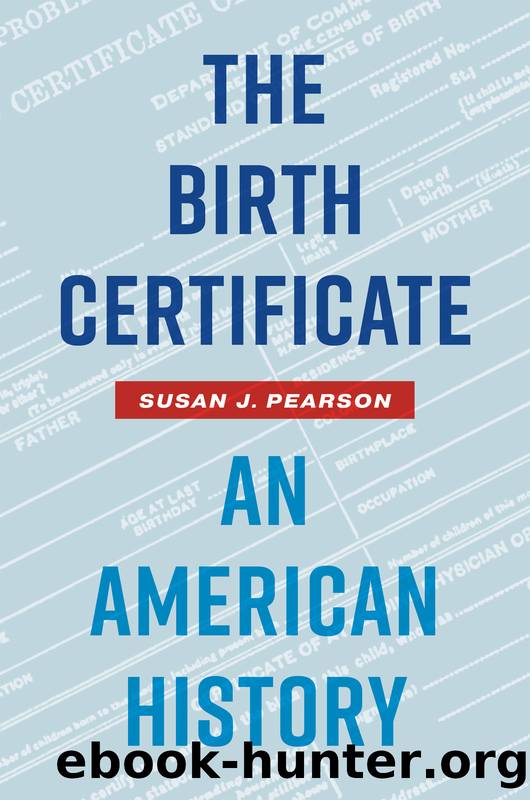The Birth Certificate by Susan J. Pearson

Author:Susan J. Pearson [Pearson, Susan J.]
Language: eng
Format: epub
ISBN: 9781469665689
Publisher: UNC Press
Published: 2021-09-15T00:00:00+00:00
Nowhere were the ideological links between vital registration and administration of the racial state made more apparent than in Virginia. In 1912 the state reformed its floundering registration system by creating a state board of health. The board included a Bureau of Vital Statistics (BVS) and a state registrar to enforce a new vital statistics registration law. The job of enforcement was given to Assistant Registrar Walter Plecker. Plecker became state registrar in 1914 and served in the post until 1946. During those years he used his position not only to collect and broadcast racial statistics but also to engage in racial purification through racial classification. Plecker and his efforts to police interracial marriages and to deny recognition to Virginiaâs Indigenous peoples are notorious. Yet the foundational role of vital documents and birth certificates in his machinations is less well understood. In Walter Pleckerâs hands, racial purity was the product of properly recorded births.
Plecker made common cause with fellow Virginians John Powell and Ernest Cox, founders of the Anglo-Saxon Clubs of America, to urge his state to pass the antimiscegenation Racial Integrity Act (RIA), which it did in 1924. The act defined âwhite,â âNegro,â and âIndianâ not only for purposes of marriage but also for âschool attendance and for all other purposes.â In the original version of the RIA, Powell and Plecker included a provision that would have required every Virginian to have a racial registration document. This provision was stripped from the final bill, but the final act forbade marriages between whites and nonwhites except those possessing âone-sixteenth or less of the blood of the American Indian and ⦠no other non-Caucasic blood.â In 1930, the act was amended to âdefine a colored person as one with any ascertainable negro blood.â This was the so-called one-drop rule. The RIA also directed the state registrar to prepare âregistration certificatesâ to record the racial history of any person born in Virginia before 1912 who lacked a birth certificate. Writing in favor of the act, Plecker argued that though his office was already the âgreatest force in the state today combating this condition [racially mixed marriages],â it would have the power to act with greater clarity and force under the terms of the RIA.27
Like Virginia, Georgia reformed its vital statistics laws in the 1910s, and it soon linked improvements in registration to improved racial classification in the service of racial purity. In 1927, Georgiaâs legislature adopted a racial integrity act that was very similar to Virginiaâs. In the run-up to the billâs passage, its sponsor, Assemblyman James C. Davis, explained that his bill included a racial registration provision so that the many Georgians who did not have their births registered could âapply to the local registrar ⦠and present satisfactory proof, and be registered under the terms of the act.â Such registration would fix both the applicantâs age and race. Other supporters of the bill were pleased that it would substitute a one-drop definition of Blackness for the current standard, which defined as white anyone with one-eighth or less of ânegro blood.
Download
This site does not store any files on its server. We only index and link to content provided by other sites. Please contact the content providers to delete copyright contents if any and email us, we'll remove relevant links or contents immediately.
| Antitrust | Civil Law |
| Emigration & Immigration | Federal Jurisdiction |
| Housing & Urban Development | Indigenous Peoples |
| Land Use | Public |
| Public Contract | Public Utilities |
| Urban, State & Local Government |
Machine Learning at Scale with H2O by Gregory Keys | David Whiting(4192)
Killers of the Flower Moon by David Grann(3971)
Oathbringer (The Stormlight Archive, Book 3) by Brandon Sanderson(2899)
Will by Will Smith(2795)
Once Upon a Broken Heart by Stephanie Garber(2682)
Guns, Germs and Steel by Diamond Jared(2304)
Borders by unknow(2232)
It Starts With Us (It Ends with Us #2) by Colleen Hoover(2203)
Friends, Lovers, and the Big Terrible Thing by Matthew Perry(2125)
The Room Where It Happened by John Bolton;(2105)
The Color of Law by Richard Rothstein(1887)
HBR's 10 Must Reads 2022 by Harvard Business Review(1778)
The Strength In Our Scars by Bianca Sparacino(1777)
A Short History of War by Jeremy Black(1764)
Water Rights and the Environment in the United States by John Burch(1644)
Examples & Explanations: Administrative Law by William F. Funk & Richard H. Seamon(1604)
515945210 by Unknown(1602)
A Game of Thrones (The Illustrated Edition) by George R. R. Martin(1594)
That Every Man Be Armed by Stephen P. Halbrook(1549)
